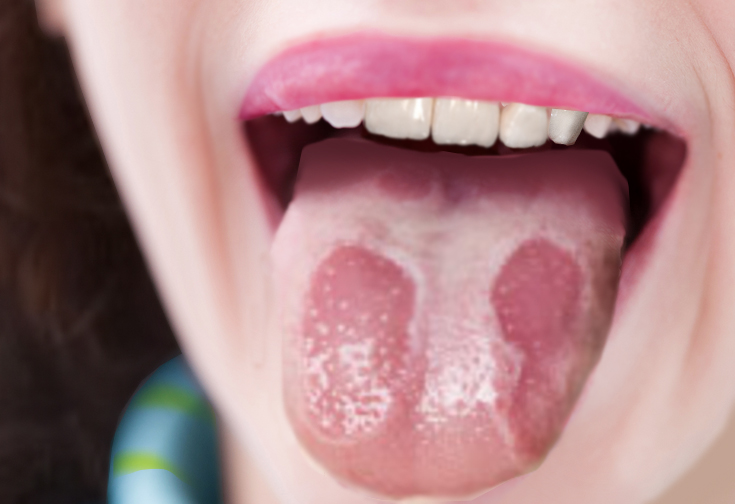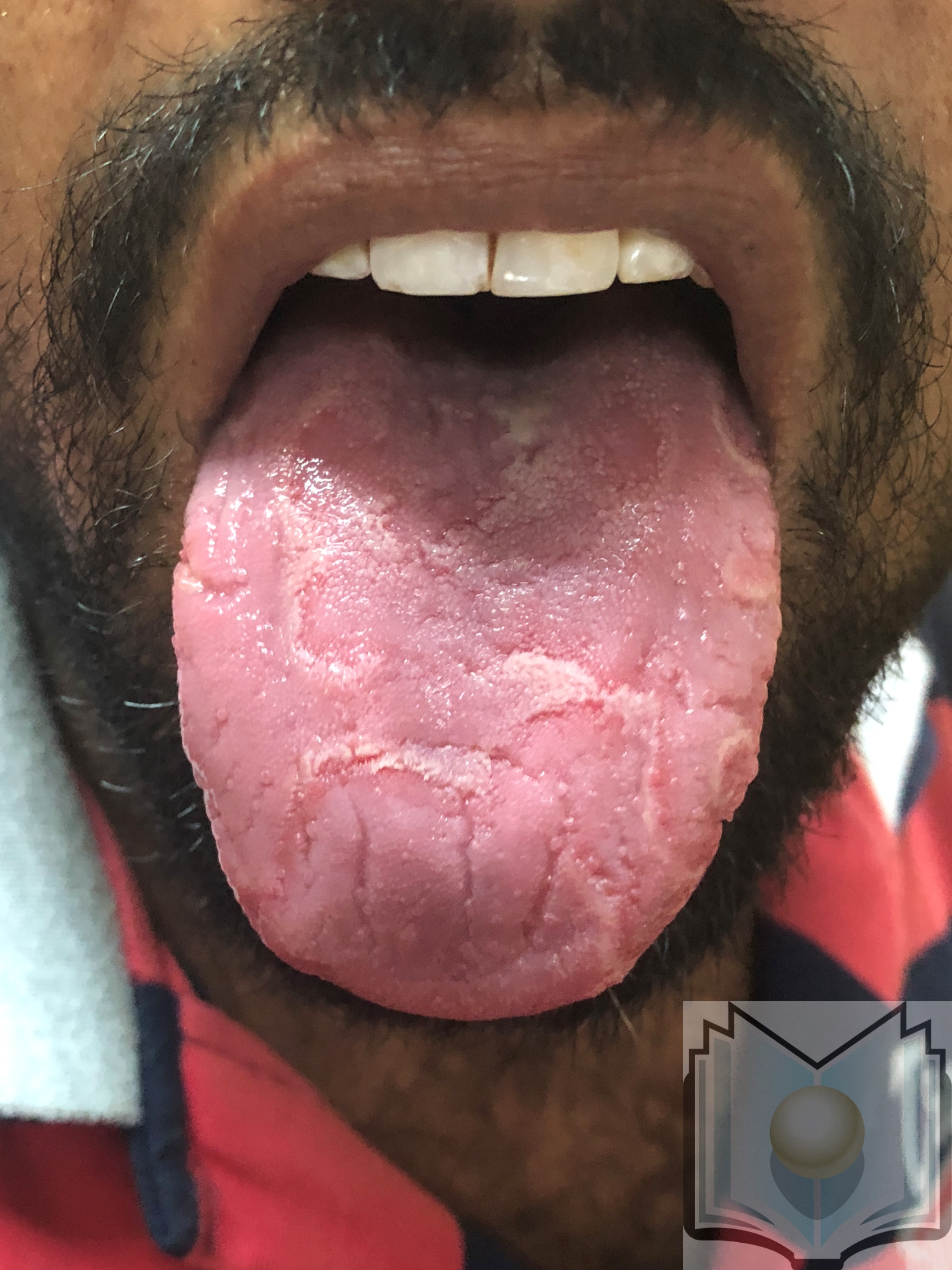Continuing Education Activity
Geographic tongue is a benign chronic relapsing recurring inflammatory condition of the oral cavity of unknown etiology. This activity reviews the evaluation and treatment of geographic tongue and highlights the role of the interprofessional team in evaluating and treating this condition. This activity reviews in detail the clinical and histopathological, pathogenesis, etiology, evaluation, associations, treatment, and management of geographic tongue.
Objectives:
- Identify the etiology of geographic tongue.
- Review the appropriate evaluation of geographic tongue.
- Outline the management options available for geographic tongue.
- Describe the interprofessional team strategies for improving care coordination and communication to advance geographic tongue and improve outcomes.
Introduction
First described by Rayer in 1831, geographic tongue is a benign chronic relapsing recurring inflammatory condition of the oral cavity of unknown etiology.[1] It can also be referred to as benign migratory glossitis, erythema migrans, annulus migrans, and a wandering rash of the tongue.[1][2][3][4] It usually manifests as asymptomatic erythematous and migratory circinate patches that give its characteristic appearance of a map.[1][5] Depending on the individual, the lesion persists for a period of several days to weeks and then disappears and reappears in a different location.[1][6] Lesions usually occur on the lateral and dorsal aspects of the tongue; however, extra-lingual lesions can be seen on lips, labial and buccal mucosa and floor of the mouth.[1][2][4] Geographic tongue has been associated with other conditions leading to different theories of the pathogenesis of the disorder.
Etiology
The etiology of geographic tongue remains largely unknown; however, a few theories have been proposed.[1][2] Psychosomatic and hereditary factors have been suggested to have a role in the etiology of geographic tongue.[2] Redman et al. showed a higher prevalence of geographic tongue in mentally ill patients.[7] Ebrahimi et al. showed that decreasing stress could help heal lesions in geographic tongue, further demonstrating an association between stress and geographic tongue[2]. A possible role of familial and hereditary factors has been suggested.[1][4] Redman et al. showed that geographic tongue was more prevalent in first degree relatives than in the control group (14.4% vs. 4%). An increased prevalence of geographic tongue in parents and siblings was significantly higher than in the general population. A polygenetic inheritance model has been proposed regarding the etiology of this disorder.[8]
Epidemiology
Geographic tongue usually begins in childhood and has an overall global prevalence of approximately 1% to 2.5% of the population. The prevalence in the pediatric population ranges from 0.37% to 14.3%. The greatest prevalence occurs in the age group of 20 to 29 years of age at about 39.4%. Geographic tongue has a slightly greater predilection for women than men.[1][2]
Pathophysiology
The pathogenesis of geographic tongue remains unknown to this date; however, several theories have been proposed.[1] Several studies have shown a link between asthma, eczema, hay fever, allergic rhinitis, patients with higher levels of immunoglobulin E, and geographic tongue.[2][4] Marks and Tait et al. observed a positive association between geographic tongue and asthma and atopy, further suggesting similar pathogenesis for both disease entities.[2] Jainkittivong et al. showed that geographic tongue was more commonly seen in patients with allergies to drugs, food, or others.[9] Miloglu et al. showed that 24.1% of patients with geographic tongue had atopy or allergic disease concurrently.[10]
Due to clinical, histopathological, and immunohistochemical similarities between geographic tongue and psoriasis, some experts believe geographic tongue to be an oral manifestation of psoriasis.[2] A strong association with human leukocyte antigen (HLA)–Cw6 and a weak association with HLA-B13 has been reported in both geographic tongue and psoriasis.[2] This association is controversial as some have stated strong evidence is lacking and that geographic tongue and psoriasis may rather occur coincidentally also given the fact that there is a large percentage of healthy patients with geographic tongue.[4]
Hormones have also been proposed to play a role in the pathogenesis of geographic tongue.[1][2][4] Wysocky and Daley found a fourfold increase in the incidence of geographic tongue and diabetes.[11] However, on the contrary, studies have also shown no significant correlation between geographic tongue and insulin-dependent diabetes mellitus.[2]
Oral contraceptive pills that cause hormonal fluctuation have been associated with geographic tongue, further indicating a possible hormonal role in this disorder.[2] Angiogenesis inhibitors have also been reported to induce geographic tongue possibly.[2]
Vitamin D, B6, B12, folic acid, iron, and zinc deficiency have also been proposed to play a role in the pathogenesis of geographic tongue.[2][4][12]
Tobacco use has been shown to play a protective role in the pathogenesis of geographic tongue.[2] The incidence of geographic tongue seems to be less in smokers than compared to nonsmokers, possibly due to increased keratinization and decreased TNF-a, IL-1, and IL-6 by macrophages via activation of nicotinic receptors.[12]
Histopathology
Microscopic examination of the white area of geographic tongue shows subepithelial infiltrates with a predominance of neutrophils forming microabscess, epithelial acanthosis associated with an elongation of the rete ridges, acantholysis, parakeratosis, glycogen deposits in the epithelial cells, and exfoliation of necrotic cells in the surface layer. The histopathology of the erythematous area of the lesion may show mononuclear subepithelial infiltrate (predominantly CD4+ T-lymphocytes), suprapapillary hypertrophy, and vascular ectasia.[1][2][12] Under electron microscopy, two types of pathology can be seen.[2] Loss of filiform papillae can be seen under the erythematous area, while necrotic cells can be seen under the white region of geographic tongue.[12]
History and Physical
Clinical presentation of geographic tongue is variable.[1] It usually presents as asymptomatic erythematous migratory atrophic circinate patches with loss of filiform papillae surrounded by white circinate borders that involve the lateral and dorsal aspects of the tongue.[3][1] If the lesions occur in different locations other than the tongue, the term ectopic geographic tongue is employed.[3] These extra-lingual lesions uncommonly occur and can be located on the labial and buccal mucosa, lips, hard palate, uvula, and floor of the mouth.[1][3][4][6] Geographic tongue undergoes periods of remission and exacerbation with varying shapes and sizes, giving it its migrating map-like pattern.[1][3] Lesions can be asymptomatic or present with symptoms such as pain, burning sensation, stomatodynia, dysgeusia, sensitivity to hot, spicy, and sour food.[1][3][4]
Evaluation
Geographic tongue is usually diagnosed by its characteristic history and clinical features.[2] Confirmation by histology is rarely necessary but may be needed in atypical cases.[1][2] Further evaluation may be needed if any of the associations with geographic tongue is suspected. Associations with chronic inflammatory bowel disease, psoriasis, celiac disease, HIV, atopic dermatitis, lichen planus, diabetes mellitus, lupus erythematosus, Down syndrome, reactive arthritis, Aarskog syndrome, fetal hydantoin syndrome, and Robinow syndrome have been reported.[1][2][3][4][12]
Treatment / Management
Geographic tongue usually does not require any treatment if asymptomatic. Patients can be reassured of its benign self limiting nature.[1] For symptomatic lesions, topical corticosteroids, antihistamines, cyclosporine, vitamin A, zinc, acetaminophen, topical tacrolimus have been shown to be effective. Avoidance of alcohol, hot, spicy and sour foods, acidic fruits and beverages, and maintaining good oral hygiene is recommended to avoid worsening symptoms.[1][2][3][4][12][6]
Differential Diagnosis
Geographic tongue is usually diagnosed by its characteristic history and clinical features. In cases of atypical lesions, differential diagnosis of geographic tongue includes erythroplakia, lichen planus, candidiasis, contact stomatitis, leukoplakia, trauma, and aphthous ulcer.[2][3][4]
- Erythroplakia
- Lichen planus
- Candidiasis
- Contact stomatitis
- Leukoplakia
- Trauma
- Aphthous ulcer
- Squamous cell cancer
- Plaque psoriasis
Prognosis
Geographic tongue is a benign usually asymptomatic condition with a good prognosis.[1]
Complications
Geographic tongue usually does not have any complications.[1]
Deterrence and Patient Education
Geographic tongue is a harmless inflammatory condition affecting the surface of the tongue. Treatment is not necessary.[2] For symptomatic cases, therapy is available.
Enhancing Healthcare Team Outcomes
An interprofessional team that provides a holistic and integrated approach to diagnosing and treating geographic tongue can help achieve the best possible outcomes. Health care staff of primary care and emergency departments play a vital role in diagnosing and referring patients with tongue lesions to dermatology or otolaryngology that look like geographic tongue. This will aid in better patient satisfaction and quality of life.
Collaboration, shared decision making, and communication are key elements for a good outcome. The interprofessional care provided to the patient must use an integrated care pathway combined with an evidence-based approach to planning and evaluation of all joint activities. The earlier signs and symptoms of geographic tongue are identified; the better is the patient outcome and satisfaction.


